Fractal Characterization of Pore Structures in Marine–Continental Transitional Shale Gas Reservoirs: A Case Study of the Shanxi Formation in the Ordos Basin
Abstract
1. Introduction
2. Geological Settings
3. Samples and Methods
3.1. Samples
3.2. Methods
3.2.1. TOC Content and X-Ray Diffraction
3.2.2. Gas Adsorption
3.2.3. High-Pressure Mercury Intrusion
3.2.4. Fractal Models
4. Results
4.1. TOC Content and Mineral Composition
4.2. Pore Structure
4.3. Pore Fractal Characteristics
4.3.1. Micropore Fractal Characteristic
4.3.2. Mesopore Fractal Characteristics
4.3.3. Macropore Fractal Characteristics
5. Discussions
5.1. Full Pore Size Characterization
5.2. The Relevance of Pore Structure to Shale Composition
5.3. The Relevance of Shale Composition to Fractal Dimensions
6. Conclusions
Author Contributions
Funding
Data Availability Statement
Conflicts of Interest
References
- Adeyilola, A.; Nordeng, S.; Onwumelu, C.; Nwachukwu, F.; Gentzis, T. Geochemical, Petrographic and Petrophysical Characterization of the Lower Bakken Shale, Divide County, North Dakota. Int. J. Coal Geol. 2020, 224, 103477. [Google Scholar] [CrossRef]
- Zhang, J.C.; Shi, M.; Wang, D.S.; Tong, Z.Z.; Hou, X.D.; Niu, J.L.; Li, X.Q.; Li, Z.M.; Zhang, P.; Huang, Y.Q. Fields and Directions for Shale Gas Exploration in China. Nat. Gas Ind. B 2022, 9, 20–32. [Google Scholar] [CrossRef]
- Guo, X.S.; Wang, R.Y.; Shen, B.J.; Wang, G.P.; Wan, C.X.; Wang, Q.R. Geological Characteristics, Resource Potential, and Development Directionof Shale Gas in China. Pet. Explor. Dev. 2025, 52, 15–28. [Google Scholar] [CrossRef]
- Nie, H.K.; Dang, W.; Zhang, K.; Su, H.K.; Ding, J.H.; Li, D.H.; Liu, X.W.; Li, P.; Li, P.; Yang, S.Y.; et al. Two Decades of Shale Gas Research & Development in China: Review and Prospects. Nat. Gas Ind. 2024, 44, 20–52. [Google Scholar] [CrossRef]
- Wu, J.; Wang, H.Y.; Shi, Z.S.; Wang, Q.; Zhao, Q.; Dong, D.Z.; Li, S.X.; Liu, D.X.; Sun, S.S.; Qiu, Z. Favorable Lithofacies Types and Genesis of Marine-Continental Transitional Black Shale: A Case Study of Permian Shanxi Formation in the Eastern Margin of Ordos Basin, NW China. Pet. Explor. Dev. 2021, 48, 1315–1328. [Google Scholar] [CrossRef]
- Guo, W.; Gao, J.L.; Li, H.; Kang, L.X.; Zhang, J.W.; Liu, G.H.; Liu, Y.Y. The Geological and Production Characteristics of Marine-Continental Transitional Shale Gas in China:Taking the Example of Shale Gas from Shanxi Formation in Ordos Basin and Longtan Formation in Sichuan Basin. Miner. Explor. 2023, 14, 448–458. [Google Scholar] [CrossRef]
- Liu, W.; Zhao, Q.; Qiu, Z.; Zhao, P.H.; Li, S.X.; Dong, D.Z.; Liu, H.L.; Hou, W.; Zhang, Q.; Xiao, Y.F.; et al. Research Status and Prospect of Accumulation Conditions of Transitional Facies Shale Gas in the Eastern Margin of Ordos Basin. Nat. Gas Geosci. 2023, 34, 868–887. [Google Scholar] [CrossRef]
- Jiang, Y.Q.; Wen, S.M.; Cai, G.Y.; Li, S.X.; Xiong, X.Y.; Li, X.T.; Dong, D.Z.; Qiu, Z.; Gu, Y.F.; Wang, Z.L.; et al. Lithologic Assemblage Characteristics and Shale Gas Exploration Potential of Transitional Shale in the Ordos Basin. Nat. Gas Ind. 2023, 43, 62–75. [Google Scholar] [CrossRef]
- Liu, J.P.; Liu, D.X.; Hu, H.Y.; Jiao, P.F.; Wang, T.; Xie, Z.T.; Liu, L.H. Pore Structure Characteristics of Marine Continental Transitional Facies Shale of Shanxi Formation in the Eastern Margin of Ordos Basin. China Sci. 2022, 17, 21–30. [Google Scholar]
- Luo, L.Y.; Li, Y.; Li, S.X.; He, Q.B.; Chen, S.J.; Li, X.; Li, X.T.; Lu, J.G.; Xiao, Z.L.; Yin, X.D. Controlling Factors of Marine and Continental Transitional Shale Gas Enrichment in Shan23 Sub-Member, Daji Area, Eastern Margin of Ordos Basin. Nat. Gas Geosci. 2024, 36, 554–566. [Google Scholar] [CrossRef]
- Ning, S.T.; Xia, P.; Hao, F.; Tian, J.Q.; Fu, Y.; Wang, K. Pore Fractal Characteristics between Marine and Marine–Continental Transitional Black Shales: A Case Study of Niutitang Formation and Longtan Formation. Fractal Fract. 2024, 8, 288. [Google Scholar] [CrossRef]
- Gao, J.; Li, X.; Cheng, G.; Luo, H.; Zhu, H. Structural Evolution and Characterization of Organic-Rich Shale from Macroscopic to Microscopic Resolution: The Significance of Tectonic Activity. Adv. Geo-Energy Res. 2023, 10, 84–90. [Google Scholar] [CrossRef]
- Wang, L.; Liu, B.; Bai, L.; Yu, Z.; Huo, Q.; Gao, Y. Pore Evolution Modeling in Natural Lacustrine Shale Influenced by Mineral Composition: Implications for Shale Oil Exploration and CO2 Storage | Advances in Geo-Energy Research. Adv. Geo-Energy Res. 2025, 13, 218–230. [Google Scholar] [CrossRef]
- Cai, J.; Jiao, X.; Wang, H.; He, W.; Xia, Y. Multiphase Fluid-Rock Interactions and Flow Behaviors in Shale Nanopores: A Comprehensive Review. Earth-Sci. Rev. 2024, 257, 104884. [Google Scholar] [CrossRef]
- Fu, C.; Xu, X.; Du, Y.; Kou, X. Experimental Study on the Influence of Pore Structure on Spontaneous Imbibition in Marine Black Shale. Capillarity 2024, 10, 57–72. [Google Scholar] [CrossRef]
- Wu, J.; Xiao, Y.F.; Liu, D.; Liu, X.; Guo, W.; Li, S.X.; Gao, J.L.; Lin, W. Heterogeneity of Shale Gas Reservoirs in Marine-Continental Transitional Facies and Its Controlling Factors:An Example of Shanxi Formation in Daning-Jixian Block on Eastern Margin of Ordos Basin. J. Northeast. Pet. Univ. 2022, 46, 12–23+97+2. [Google Scholar] [CrossRef]
- He, C.C.; Zhao, Y.Q.; Yu, L.G.; Lu, L.F.; Liu, W.X.; Pan, A.Y.; Li, C.X. Pore Structure and Fractal Characteristics of Deep Shale Gas Reservoirs in the Permian Dalong Formation, Northeastern Sichuan Basin. Pet. Geol. Exp. 2024, 46, 263–277. [Google Scholar] [CrossRef]
- Xia, X.; Jiao, X.; Li, J.; Shen, W.; Xia, Y.; Wang, H. Gas Adsorption Behavior in Shale Reservoirs: Insights from Molecular Scale. Capillarity 2024, 13, 68–72. [Google Scholar] [CrossRef]
- He, X.P.; Cai, X.; Gao, Y.Q.; Ding, A.X.; Jiang, Z.G.; He, G.S.; Xia, W.; Zeng, J. Experimental Technologies of Shale Gas Exploration and Development: Research Progress and Development Direction. Nat. Gas Ind. 2024, 44, 12–26. [Google Scholar] [CrossRef]
- Dai, F.; Hu, H.; Zhang, A. Suitability Study on Fractal Model of Organic Shale Pore. Coal Sci. Technol. 2019, 47, 168–175. [Google Scholar] [CrossRef]
- Wang, Z.L.; Guo, B.; Jiang, C.; Qi, L.; Jiang, Y.Q.; Gu, Y.F.; Fu, Y.H.; Liang, D.M. Nanoscale Pore Characteristics of the Lower Permian Shanxi Formation Transitional Facies Shale, Eastern Ordos Basin, North China. Front. Earth Sci. 2022, 10, 842955. [Google Scholar] [CrossRef]
- Xia, Y.; Cai, J.; Perfect, E.; Wei, W.; Zhang, Q.; Meng, Q. Fractal Dimension, Lacunarity and Succolarity Analyses on CT Images of Reservoir Rocks for Permeability Prediction. J. Hydrol. 2019, 579, 124198. [Google Scholar] [CrossRef]
- Zhao, B.S.; Li, R.X.; Qin, X.L.; Wang, N.; Zhou, W.; Khaled, A.; Zhao, D.; Zhang, Y.N.; Wu, X.L.; Liu, Q. Geochemical Characteristics and Mechanism of Organic Matter Accumulation of Marine-Continental Transitional Shale of the Lower Permian Shanxi Formation, Southeastern Ordos Basin, North China. J. Pet. Sci. Eng. 2021, 205, 108815. [Google Scholar] [CrossRef]
- Li, Y.; Xu, L.F.; Wu, P.; Hu, W.Q.; Liu, C.; Li, M. Lithofacies Characteristics and Reservoir Differences of Marine-Continental Transitional Shale in the Eastern Margin of the Ordos Basin. Nat. Gas Ind. 2023, 43, 38–54. [Google Scholar] [CrossRef]
- Yang, C.; Zhang, J.C.; Wang, X.Z.; Tang, X.; Chen, Y.C.; Jiang, L.L.; Gong, X. Nanoscale Pore Structure and Fractal Characteristics of a Marine-Continental Transitional Shale: A Case Study from the Lower Permian Shanxi Shale in the Southeastern Ordos Basin, China. Mar. Pet. Geol. 2017, 88, 54–68. [Google Scholar] [CrossRef]
- Kuang, L.C.; Dong, D.Z.; He, W.Y.; Wen, S.M.; Sun, S.S.; Li, S.X.; Qiu, Z.; Liao, X.W.; Li, Y.; Wu, J.; et al. Geological Characteristics and Development Potential of Transitional Shale Gas in the East Margin of the Ordos Basin, NW China. Pet. Explor. Dev. 2020, 47, 435–446. [Google Scholar] [CrossRef]
- Lan, Z.L.; Guo, W.; Wang, Q.; Zhang, X. Shale Gas Accumulation Condition and Favorable Area Optimization of the Permian Shanxi Formation, Eastern Ordos Basin. Acta Geol. Sin. 2016, 90, 177–188. [Google Scholar]
- Xue, Y.K.; Dang, W.; Zhang, Q.; Liu, J.; Shangguan, L.D.; Lei, Y.Z.; Zhang, X.; Feng, Y.B.; Qiu, Z. Lithofacies and Its Reservoir Characteristics of Marine–Continental Transitional Shales: A Case Study of Shanxi Formation in Eastern Ordos Basin. Energy Fuels 2024, 38, 18441–18456. [Google Scholar] [CrossRef]
- Wang, Y.C.; Zhang, L.F.; Qiu, Z.; Peng, S.Z.; Feng, C.J.; Sun, M.S. Lithofacies types and reservoir characteristics of transitional shales of the Permian Shan23 sub-member, eastern Ordos Basin. Nat. Gas Geosci. 2022, 33, 418–430. [Google Scholar] [CrossRef]
- GB/T 19145-2022; Determination for Total Organic Carbon in Sedimentary Rock. State Administration for Market Regulation (SAMR) and Standardization Administration of China (SAC): Beijing, China, 2022.
- SY/T 5163-2018; X-Ray Diffraction Analysis Methods for Clay Minerals and Common Non-Clay Minerals in Sedimentary Rocks. National Energy Administration (NEA): Beijing, China, 2018.
- Dang, W.; Jiang, S.; Zhang, J.C.; Li, P.; Nie, H.K.; Liu, Y.; Li, F.; Sun, J.T.; Tao, J.; Shan, C.A.; et al. A Systematic Experimental and Modeling Study of Water Adsorption/Desorption Behavior in Organic-Rich Shale with Different Particle Sizes. Chem. Eng. J. 2021, 426, 130596. [Google Scholar] [CrossRef]
- Gu, Y.T.; Wan, Q.; Li, X.X. The Selection of Outgas Temperature for Shale in Low-Pressure N2 Adsorption: An Evidence from Thermogravimetry. Energy Explor. Exploit. 2021, 39, 1685–1696. [Google Scholar] [CrossRef]
- GB/T 21650-2008; Pore Size Distribution and Porosity of Solid Materials by Mercury Porosimetry and Gas Adsorption—Part 1: Mercury Porosimetry. Beijing Center for Physical and Chemical Analysis and Institute of Process Engineering, Chinese Academy of Sciences (IPE, CAS): Beijing, China, 2008.
- Mandelbrot, B.B. The Fractal Geometry of Nature; Revised and Enlarged Edition; Times Books: Singapore, 1983. [Google Scholar]
- Lowell, S.; Shields, J.E.; Thomas, M.A.; Thommes, M. Characterization of Porous Solids and Powders: Surface Area, Pore Size and Density; Springer Science & Business Media: Berlin/Heidelberg, Germany, 2012; Volume 16, ISBN 978-1-4020-2303-3. [Google Scholar]
- Wang, X.Q.; Zhu, Y.M.; Wang, Y. Fractal Characteristics of Micro- and Mesopores in the Longmaxi Shale. Energies 2020, 13, 1349. [Google Scholar] [CrossRef]
- Avnir, D.; Jaroniec, M. An Isotherm Equation for Adsorption on Fractal Surfaces of Heterogeneous Porous Materials. Langmuir 1989, 5, 1431–1433. [Google Scholar] [CrossRef]
- He, C.Z.; Hua, M.Q. Fractal Geometry Description of Reservoir Pore Structure. Oil Gas Geol. 1998, 19, 15–23. [Google Scholar]
- Wang, Y.; Zhong, B.Y.; Zhang, Y.S.; Zhu, Y.M.; Wang, M. Analysis of Nanostructures and Wettability of Marine Shale in Southern China, Based on Different Fractal Models. Fractal Fract. 2025, 9, 12. [Google Scholar] [CrossRef]
- Jiang, W.; Zhang, Y.; Ma, T.R.; Chen, S.; Hu, Y.; Wei, Q.; Zhuang, D.X. Pore Structure and Its Fractal Dimension: A Case Study of the Marine Shales of the Niutitang Formation in Northwest Hunan, South China. Fractal Fract. 2025, 9, 49. [Google Scholar] [CrossRef]
- Standard Methods for the Analysis of Oils, Fats and Derivatives. In Standard Methods for the Analysis of Oils, Fats and Derivatives; International Union of Pure and Applied Chemistry: Zurich, Switzerland, 1992.
- Sing, K.S.W. Reporting Physisorption Data for Gas/Solid Systems with Special Reference to the Determination of Surface Area and Porosity (Recommendations 1984). Pure Appl. Chem. 1985, 57, 603–619. [Google Scholar] [CrossRef]
- Everett, D.H.; Koopal, L.K. International Union of Pure and Applied Chemistry. Polymer 2001, 31, 1598. [Google Scholar]
- Wang, S.D.; Chen, F.Y.; Yue, S.H.; Hu, J.; Ding, H.R.; Lu, A.H. Multifractal Characterization of Pore Structure of Coals Using Gas Adsorption Experiment and Mercury Intrusion Porosimetry (MIP). Fractal Fract. 2025, 9, 183. [Google Scholar] [CrossRef]
- Xie, W.D.; Wang, M.; Wang, H.; Duan, H.Y. Multi-Scale Fractal Characteristics of Pores in Transitional Shale Gas Reservoir. Nat. Gas Geosci. 2022, 33, 451–460. [Google Scholar] [CrossRef]
- Li, Z. Characteristics and Influencing Factors of Shale Pore Structure in Zhangye 1 Well in Xuanhua Basin. Complex Hydrocarb. Reserv. 2025, 18, 152–159+166. [Google Scholar] [CrossRef]
- Zhang, P.; Zhang, X.; Wang, K. Study on Pore Characteristics of High Rank Coal in Shangqiu Area Based on Low-Temperature Nitrogen Adsorption Method. Coal Geol. China 2023, 35, 39–45. [Google Scholar] [CrossRef]
- Liu, J.J.; Zhang, Y.L.; Yang, D.; Gao, Z.Y.; Wang, D. Joint Characterization of Middle and Low Rank Coal Pores and Fracturesbased on Pressed Mercury-Nitrogen Adsorption-Nuclear Magnetic Resonance Method. J. Henan Polytech. Univ. 2024, 1–15. [Google Scholar] [CrossRef]
- Chandra, D.; Vishal, V.; Bahadur, J.; Sen, D. A Novel Approach to Identify Accessible and Inaccessible Pores in Gas Shales Using Combined Low-Pressure Sorption and SAXS/SANS Analysis. Int. J. Coal Geol. 2020, 228, 103556. [Google Scholar] [CrossRef]
- Hazra, B.; Wood, D.A.; Vishal, V.; Varma, A.K.; Sakha, D.; Singh, A.K. Porosity Controls and Fractal Disposition of Organic-Rich Permian Shales Using Low-Pressure Adsorption Techniques. Fuel 2018, 220, 837–848. [Google Scholar] [CrossRef]
- Li, P.; Chen, H.R.; Wang, Y.; Zhu, Y.M.; Jiang, Z.F.; Wang, Y. Pore Fractal Characteristics of marine-continental transitional shale of Shanxi Formation in Kaiping syncline. Nat. Gas Geosci. 2025, 1–20. [Google Scholar] [CrossRef]
- Wang, D.X.; Xie, Z.T.; Hu, H.Y.; Wang, T.; Deng, Z. Pore Structure and Fractal Characteristics of Marine–Continental Transitional Black Shales: A Case Study of the Permian Shanxi Formation in the Eastern Margin of the Ordos Basin. Processes 2023, 11, 1424. [Google Scholar] [CrossRef]
- Yang, M.P.; Pan, Y.Y.; Feng, H.Y.; Yan, Q.; Lu, Y.J.; Wang, W.X.; Qi, Y.; Zhu, H.J. Fractal Characteristics of Pore Structure of Longmaxi Shales with Different Burial Depths in Southern Sichuan and Its Geological Significance. Fractal Fract. 2024, 9, 2. [Google Scholar] [CrossRef]
- Zhang, J.Z.; Li, X.Q.; Zhang, G.W.; Zou, X.Y.; Wang, F.Y.; Tang, Y.J. Microstructural Investigation of Different Nanopore Types in Marine-Continental Transitional Shales: Examples from the Longtan Formation in Southern Sichuan Basin, South China. Mar. Pet. Geol. 2019, 110, 912–927. [Google Scholar] [CrossRef]
- Li, X. Controlling Factors and Evaluation of Storage Capacity in Marine Shale and Transitional Shale of South China. Ph.D. Thesis, China University of Petroleum, Beijing, China, 2020. [Google Scholar]
- Yang, Y.Y.; Zhang, J.C.; Xu, L.F.; Li, P.; Liu, Y.; Dang, W. Pore Structure and Fractal Characteristics of Deep Shale: A Case Study from Permian Shanxi Formation Shale, from the Ordos Basin. ACS Omega 2022, 7, 9229–9243. [Google Scholar] [CrossRef]
- Zhao, T.Y.; Li, X.F.; Ning, Z.F.; Zhao, H.W.; Zhang, J.L.; Zhao, W. Pore Structure and Adsorption Behavior of Shale Gas Reservoir with Influence of Maturity: A Case Study of Lower Silurian Longmaxi Formation in China. Arab. J. Geosci. 2018, 11, 353. [Google Scholar] [CrossRef]
- Tian, H.; Pan, L.; Xiao, X.M.; Wilkins, R.W.T.; Meng, Z.P.; Huang, B.J. A Preliminary Study on the Pore Characterization of Lower Silurian Black Shales in the Chuandong Thrust Fold Belt, Southwestern China Using Low Pressure N2 Adsorption and FE-SEM Methods. Mar. Pet. Geol. 2013, 48, 8–19. [Google Scholar] [CrossRef]
- Shi, S.; He, J.X.; Zhang, X.L.; Wu, H.C.; Yu, Z.Q.; Wang, J.; Yang, T.T.; Wang, W. Fractal Analysis of Pore Structures in Transitional Shale Gas Reservoirs in the Linxing Area, Ordos Basin. Front. Earth Sci. 2022, 10, 979039. [Google Scholar] [CrossRef]
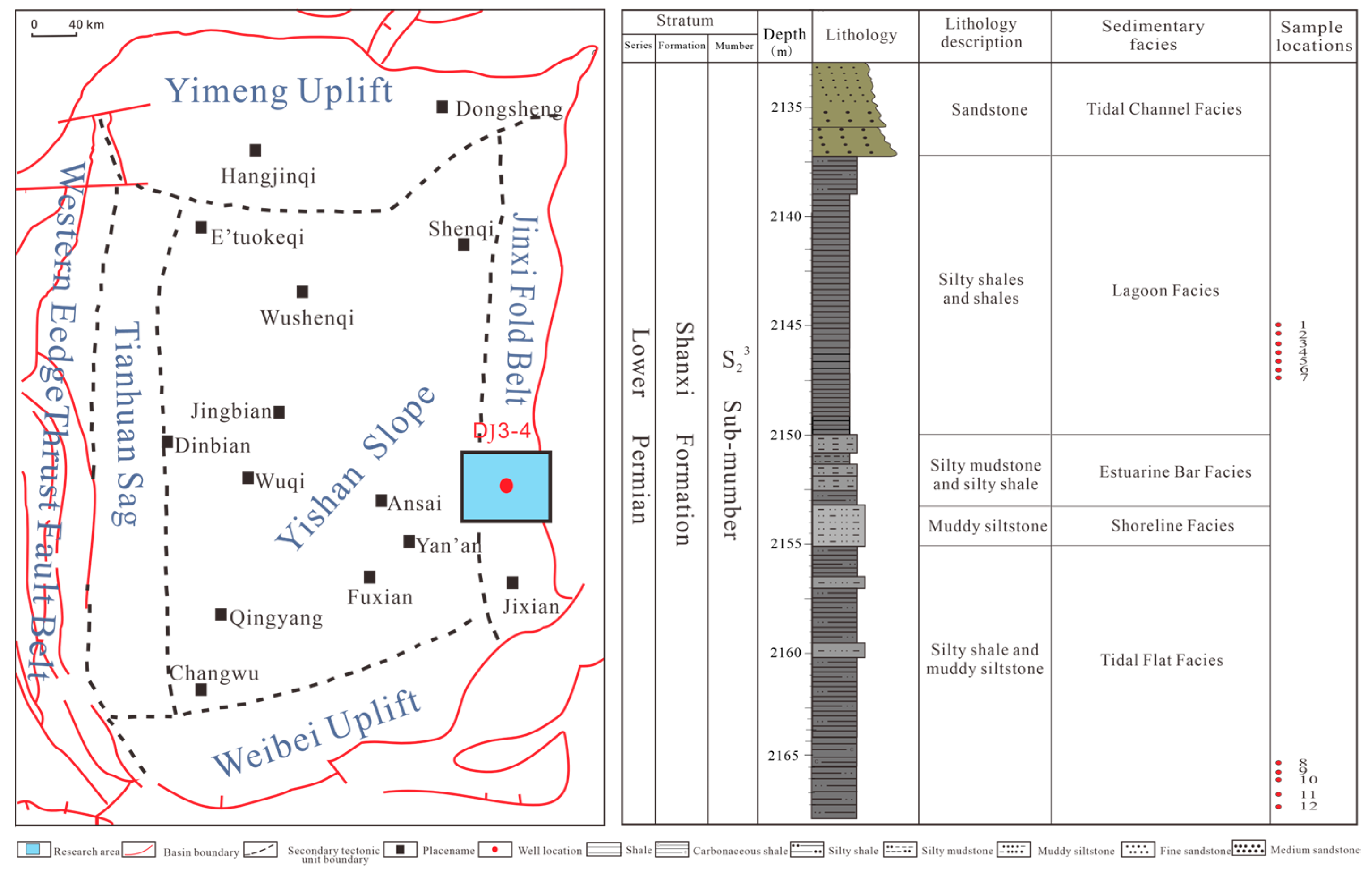




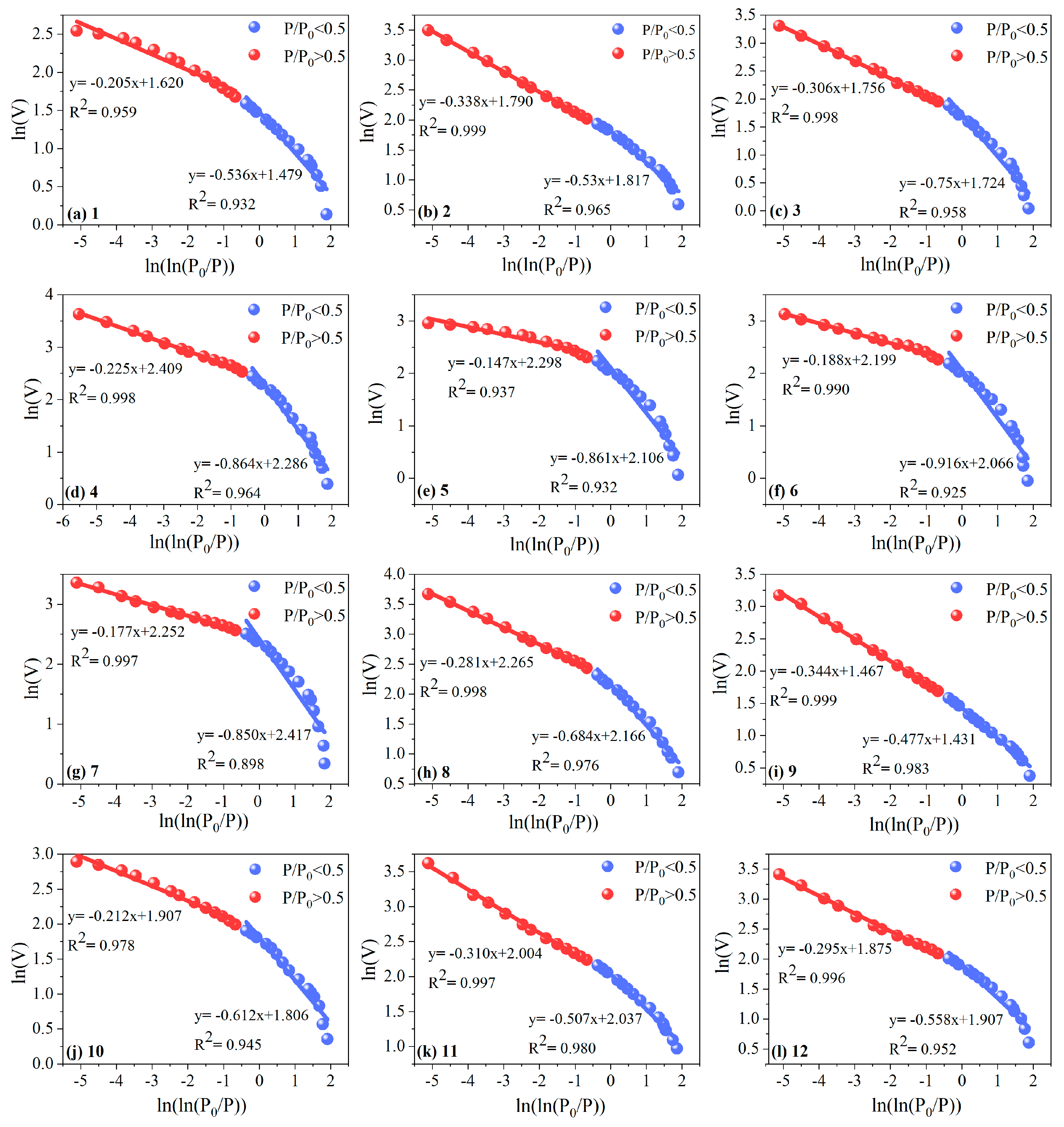
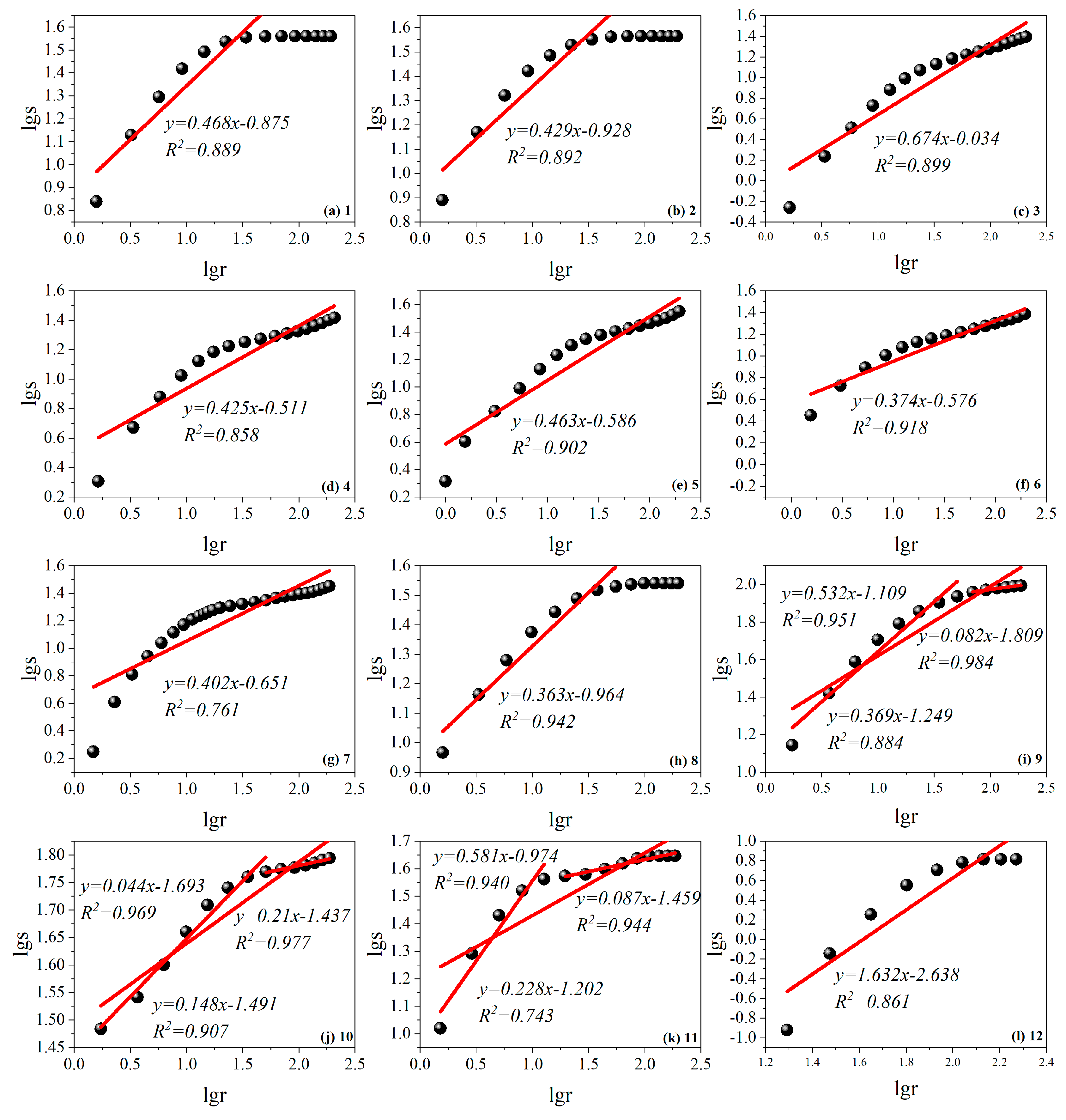
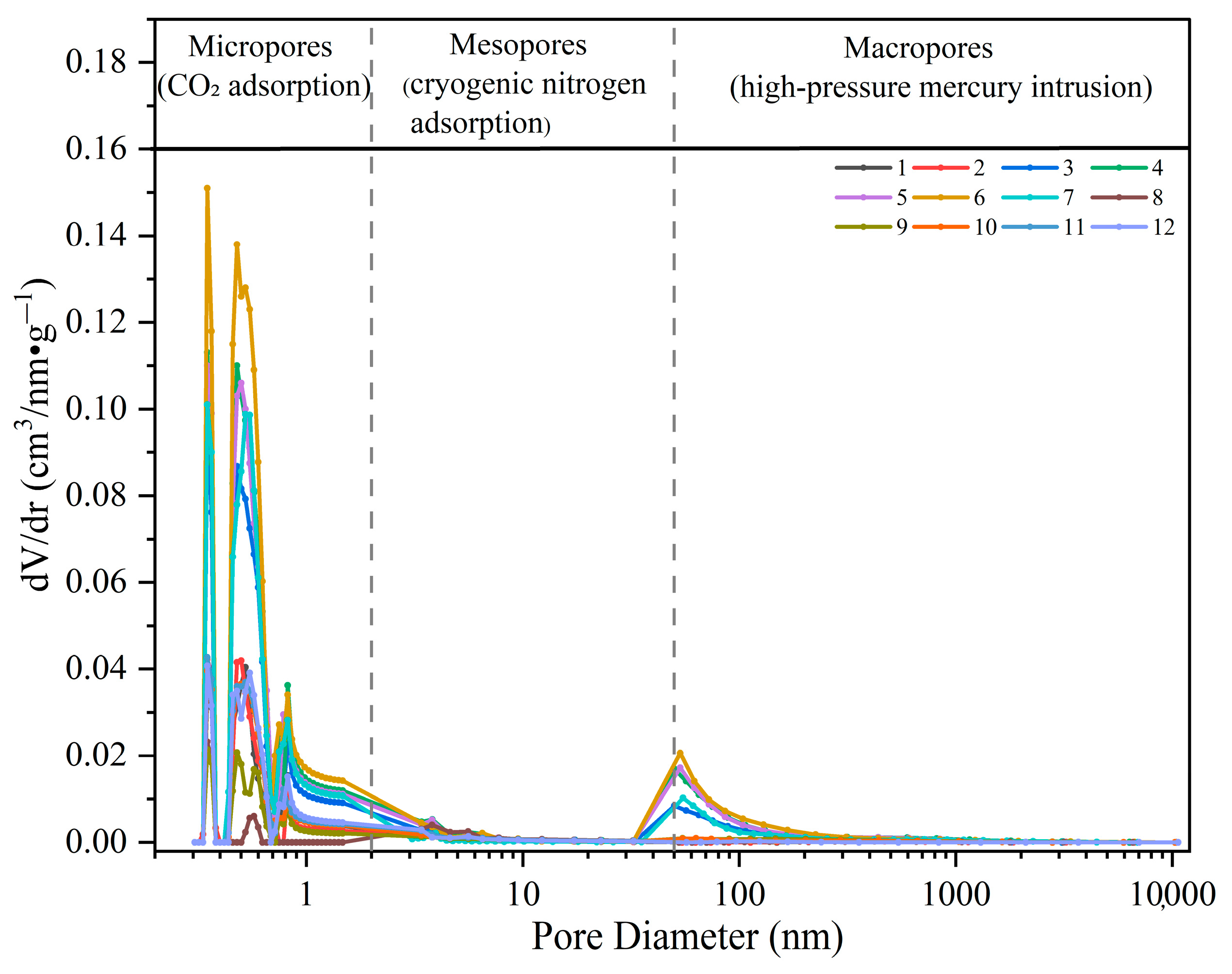
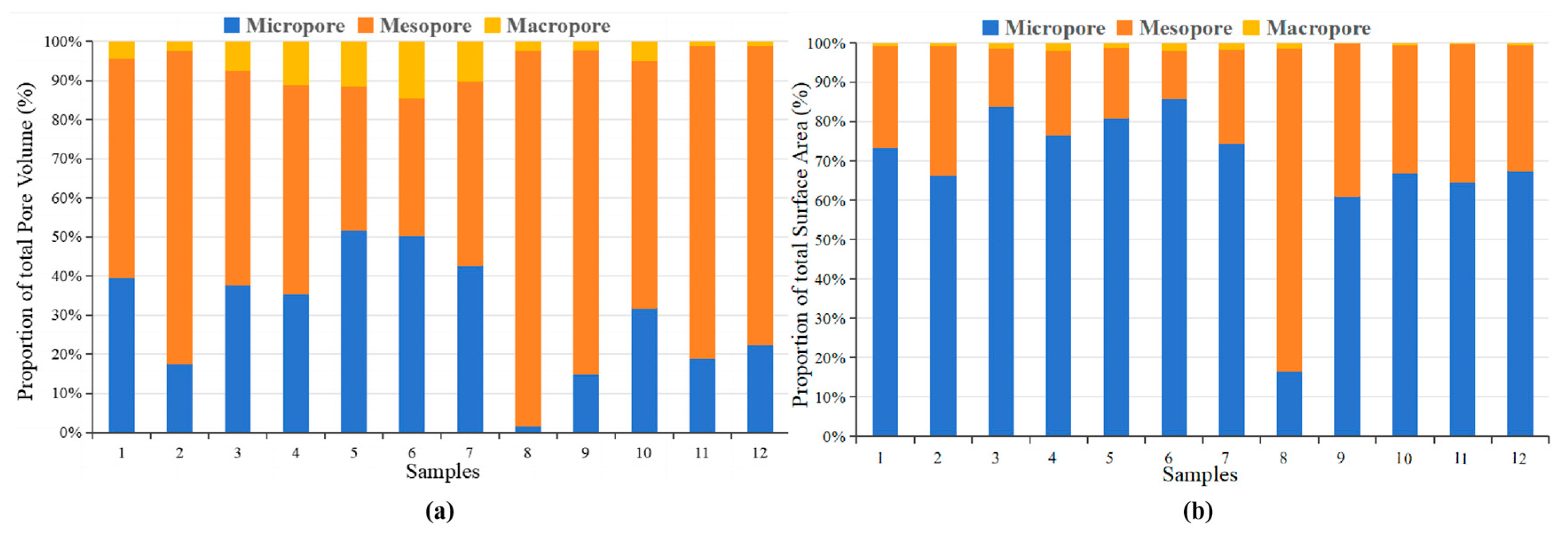
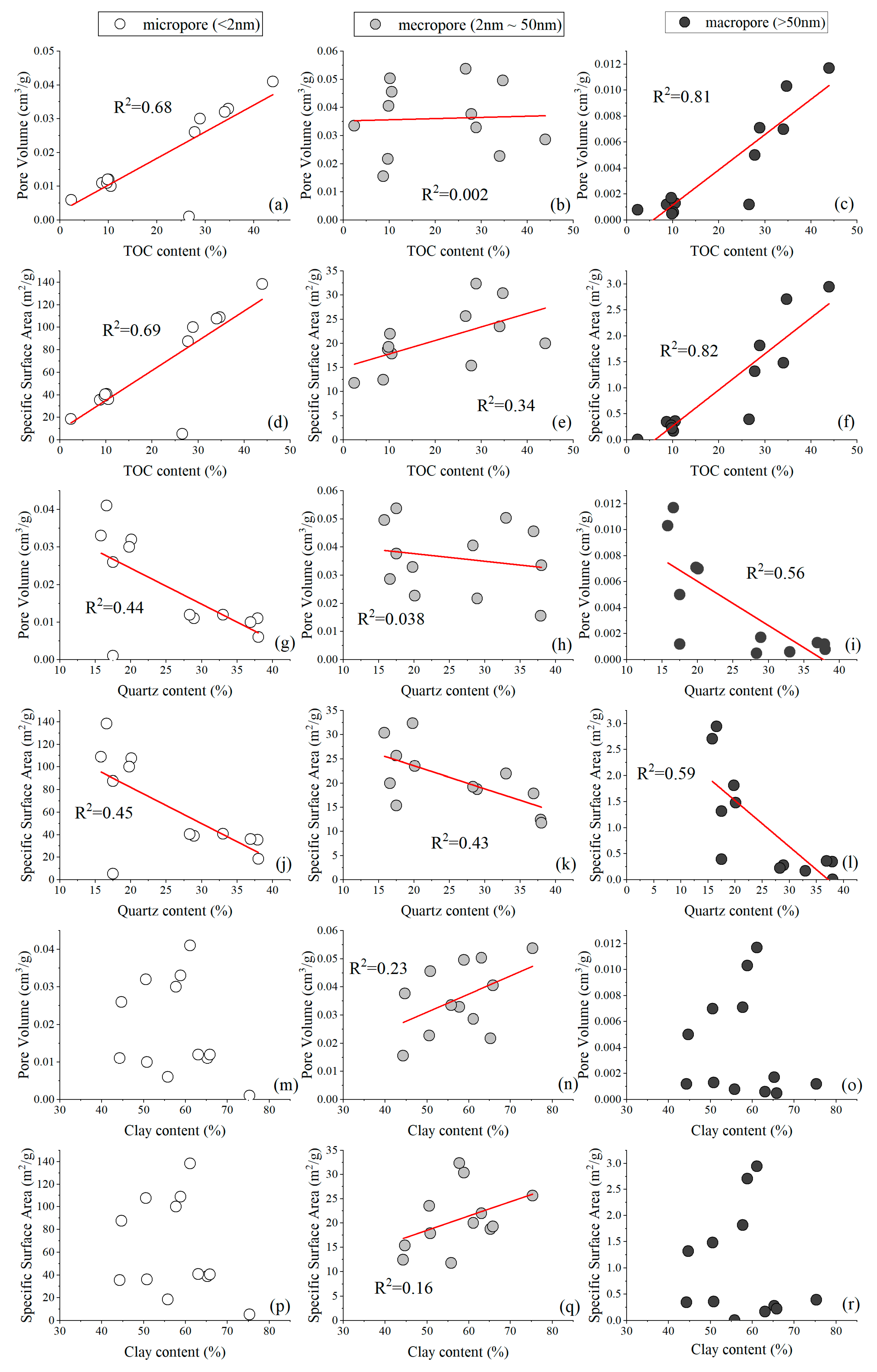

| Sample No. | Depth (m) | TOC(%) | Quartz (%) | Feldspar (%) | Siderite (%) | Ferroan Dolomite (%) | Calcite (%) | Pyrite (%) | Clay Minerals (%) | Illite–Smectite (I/S) (%) | Illite (I) (%) | Kaolinite (K) (%) | Chlorite (C) (%) |
|---|---|---|---|---|---|---|---|---|---|---|---|---|---|
| 1 | 2145.21 | 8.66 | 37.9 | 0 | 0 | 2.5 | 11 | 4.3 | 44.3 | 32 | 26 | 39 | 2 |
| 2 | 2145.34 | 10.5 | 36.9 | 0 | 0 | 1.6 | 6.9 | 3.8 | 50.8 | 33 | 30 | 35 | 2 |
| 3 | 2145.57 | 27.8 | 17.5 | 0 | 0 | 0 | 26.8 | 11.0 | 44.7 | 22 | 29 | 40 | 9 |
| 4 | 2145.86 | 34.7 | 15.8 | 0 | 3.0 | 2.4 | 6.7 | 13.3 | 58.8 | 15 | 32 | 48 | 5 |
| 5 | 2146.23 | 34 | 20.1 | 0 | 0 | 0 | 13.1 | 16.3 | 50.5 | 8 | 23 | 62 | 7 |
| 6 | 2146.48 | 43.9 | 16.6 | 0 | 0 | 2.3 | 6.0 | 14.0 | 61.1 | 12 | 27 | 54 | 7 |
| 7 | 2147.11 | 28.9 | 19.8 | 0 | 1.2 | 9.6 | 2.0 | 9.7 | 57.7 | 9 | 20 | 63 | 8 |
| 8 | 2165.61 | 26.6 | 17.5 | 0 | 0 | 6.4 | 0 | 0.8 | 75.3 | 10 | 13 | 71 | 6 |
| 9 | 2165.87 | 2.37 | 38.0 | 4 | 1.1 | 0 | 0 | 1.1 | 55.8 | 25 | 36 | 35 | 4 |
| 10 | 2166.09 | 9.7 | 28.9 | 0 | 0 | 0 | 0 | 5.9 | 65.2 | 15 | 18 | 60 | 8 |
| 11 | 2166.95 | 10.1 | 33.0 | 0 | 0 | 0 | 0 | 4.0 | 63.0 | 10 | 23 | 60 | 7 |
| 12 | 2167.23 | 9.85 | 28.3 | 0 | 2.7 | 0 | 0 | 3.2 | 65.8 | 13 | 25 | 59 | 4 |
| Sample No. | Depth (m) | Pore Volume (cm3/g) | Surface Area (m2/g) | Particle Density (g/cm3) | Porosity (%) |
|---|---|---|---|---|---|
| 1 | 2145.21 | 0.0012 | 0.35 | 2.50 | 0.31 |
| 2 | 2145.34 | 0.0013 | 0.36 | 2.51 | 0.31 |
| 3 | 2145.57 | 0.0050 | 1.32 | 2.47 | 1.24 |
| 4 | 2145.86 | 0.0103 | 2.70 | 2.44 | 2.52 |
| 5 | 2146.23 | 0.0070 | 1.48 | 2.46 | 1.72 |
| 6 | 2146.48 | 0.0117 | 2.95 | 2.44 | 2.84 |
| 7 | 2147.11 | 0.0071 | 1.82 | 2.46 | 1.76 |
| 8 | 2165.61 | 0.0012 | 0.40 | 2.50 | 0.31 |
| 9 | 2165.87 | 0.0008 | 0.01 | 2.50 | 0.21 |
| 10 | 2166.09 | 0.0017 | 0.28 | 2.50 | 0.41 |
| 11 | 2166.95 | 0.0006 | 0.17 | 2.50 | 0.15 |
| 12 | 2167.23 | 0.0005 | 0.23 | 2.51 | 0.14 |
| Sample No. | Micropores | Mesopores | Macropores | Full Pore Size | |||||
|---|---|---|---|---|---|---|---|---|---|
| DC | R2 | DN1 | R2 | DN2 | R2 | DM | R2 | DS | |
| 1 | 2.457 | 0.996 | 2.464 | 0.932 | 2.795 | 0.959 | 2.532 | 0.889 | 2.557 |
| 2 | 2.586 | 0.996 | 2.47 | 0.965 | 2.662 | 0.999 | 2.571 | 0.892 | 2.570 |
| 3 | 2.49 | 0.996 | 2.25 | 0.958 | 2.694 | 0.998 | 2.326 | 0.899 | 2.468 |
| 4 | 2.502 | 0.996 | 2.136 | 0.964 | 2.775 | 0.998 | 2.575 | 0.858 | 2.485 |
| 5 | 2.472 | 0.996 | 2.139 | 0.932 | 2.853 | 0.937 | 2.537 | 0.902 | 2.488 |
| 6 | 2.487 | 0.996 | 2.084 | 0.925 | 2.812 | 0.990 | 2.226 | 0.918 | 2.436 |
| 7 | 2.466 | 0.996 | 2.15 | 0.898 | 2.823 | 0.997 | 2.598 | 0.761 | 2.489 |
| 8 | 2.259 | 0.987 | 2.316 | 0.976 | 2.719 | 0.998 | 2.637 | 0.942 | 2.515 |
| 9 | 2.613 | 0.995 | 2.523 | 0.983 | 2.656 | 0.999 | 2.631 | 0.884 | 2.594 |
| 10 | 2.469 | 0.996 | 2.388 | 0.945 | 2.788 | 0.978 | 2.852 | 0.907 | 2.563 |
| 11 | 2.463 | 0.996 | 2.493 | 0.980 | 2.69 | 0.997 | 2.772 | 0.743 | 2.569 |
| 12 | 2.463 | 0.996 | 2.442 | 0.952 | 2.705 | 0.996 | 1.368 | 0.861 | 2.537 |
Disclaimer/Publisher’s Note: The statements, opinions and data contained in all publications are solely those of the individual author(s) and contributor(s) and not of MDPI and/or the editor(s). MDPI and/or the editor(s) disclaim responsibility for any injury to people or property resulting from any ideas, methods, instructions or products referred to in the content. |
© 2025 by the authors. Licensee MDPI, Basel, Switzerland. This article is an open access article distributed under the terms and conditions of the Creative Commons Attribution (CC BY) license (https://creativecommons.org/licenses/by/4.0/).
Share and Cite
Zhang, J.; Dang, W.; Zhang, Q.; Wang, X.; Du, G.; Shan, C.; Lei, Y.; Shangguan, L.; Xue, Y.; Zhang, X. Fractal Characterization of Pore Structures in Marine–Continental Transitional Shale Gas Reservoirs: A Case Study of the Shanxi Formation in the Ordos Basin. Energies 2025, 18, 4013. https://doi.org/10.3390/en18154013
Zhang J, Dang W, Zhang Q, Wang X, Du G, Shan C, Lei Y, Shangguan L, Xue Y, Zhang X. Fractal Characterization of Pore Structures in Marine–Continental Transitional Shale Gas Reservoirs: A Case Study of the Shanxi Formation in the Ordos Basin. Energies. 2025; 18(15):4013. https://doi.org/10.3390/en18154013
Chicago/Turabian StyleZhang, Jiao, Wei Dang, Qin Zhang, Xiaofeng Wang, Guichao Du, Changan Shan, Yunze Lei, Lindong Shangguan, Yankai Xue, and Xin Zhang. 2025. "Fractal Characterization of Pore Structures in Marine–Continental Transitional Shale Gas Reservoirs: A Case Study of the Shanxi Formation in the Ordos Basin" Energies 18, no. 15: 4013. https://doi.org/10.3390/en18154013
APA StyleZhang, J., Dang, W., Zhang, Q., Wang, X., Du, G., Shan, C., Lei, Y., Shangguan, L., Xue, Y., & Zhang, X. (2025). Fractal Characterization of Pore Structures in Marine–Continental Transitional Shale Gas Reservoirs: A Case Study of the Shanxi Formation in the Ordos Basin. Energies, 18(15), 4013. https://doi.org/10.3390/en18154013







